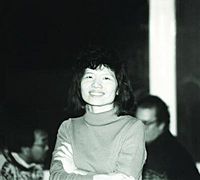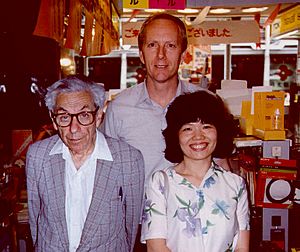Fan Chung facts for kids
Quick facts for kids
Fan Chung
|
|
|---|---|
| 金芳蓉 | |

Fan Chung in 1987
|
|
| Born | October 9, 1949 |
| Alma mater | National Taiwan University (BS) University of Pennsylvania (MS, PhD) |
| Known for | Spectral graph theory extremal graph theory Random graphs |
| Spouse(s) | |
| Scientific career | |
| Fields | Mathematics, combinatorics |
| Institutions | University of Pennsylvania University of California, San Diego |
| Thesis | Ramsey Numbers in Multi-Colors and combinatorial designs (1974) |
| Doctoral advisor | Herbert Wilf |
| Doctoral students | Steve Butler |
Fan-Rong King Chung Graham, known as Fan Chung, is a famous Taiwanese-American mathematician. She was born on October 9, 1949. She is well-known for her work in special areas of mathematics. These include spectral graph theory, extremal graph theory, and random graphs. Her work helps us understand how different things are connected, like friends on social media or pages on the internet.
Since 1998, Dr. Chung has been a special professor at the University of California, San Diego (UCSD). She earned her highest degree, a doctorate, from the University of Pennsylvania in 1974. Her advisor was Herbert Wilf. After working at Bell Laboratories for many years, she became the first female tenured professor in mathematics at the University of Pennsylvania.
Dr. Chung is part of the team that edits many international math journals. Since 2003, she has been the main editor of Internet Mathematics. She has given talks at many important math conferences. In 2009, she was chosen as a Noether Lecturer, a special honor for women in mathematics. In 2024, she was elected to the United States National Academy of Sciences.
Contents
Biography
Fan Chung was born on October 9, 1949, in Kaohsiung, Taiwan. Her father was an engineer, and he helped her become interested in mathematics. She especially liked combinatorics when she was in high school.
After high school, Chung went to the National Taiwan University (NTU) to study mathematics. She was surrounded by many female mathematicians there. This encouraged her to continue studying math.
Early Studies and Discoveries
After graduating from NTU, Chung went to the University of Pennsylvania. She wanted to continue her math career there. She got the highest score on a special exam, which caught the attention of Herbert Wilf. He later became her doctoral advisor.
Wilf suggested she study Ramsey theory. In just one week, Chung found new ways to prove things that were already known in this field. Wilf was very impressed. He said she had already done a big part of her doctoral work in that short time.
Chung earned her Master of Science (M.S.) degree in 1972. She then earned her Doctor of Philosophy (Ph.D.) degree in 1974. By this time, she was married and had her first child. After getting her Ph.D., she started working at Bell Laboratories.
Working at Bell Laboratories
In 1974, Fan Chung joined the Mathematical Foundations of Computing Department at Bell Laboratories. This was in Murray Hill, New Jersey. She worked under Henry Otto Pollak. At Bell Laboratories, Chung worked with many other excellent mathematicians.
In 1975, she published her first paper with Ronald Graham. It was about "multicolor Ramsey numbers for complete bipartite graphs." This paper was published in a math journal.
In 1983, the Bell Telephone Company was divided into smaller companies. Henry Pollak became the head of a research group in a new company. He asked Chung to become a Research Manager. In this role, she supervised many mathematicians.
She once said that she wanted people to admire her for her math, not just for her management position. In 1990, she received a special fellowship. This allowed her to spend time at Harvard University.
Later Career and Impact
After working for twenty years at Bell Laboratories and Bellcore, Chung decided to become a professor. She returned to the University of Pennsylvania. In 1998, she became a Distinguished Professor of Mathematics at the University of California, San Diego.
Beyond her work in graph theory, Dr. Chung has used her math skills to connect different areas of science. She explained that graph theory has changed a lot. This is because of the huge amount of information we have today.
She noted that we can understand large amounts of data by looking at how things are connected. For example, Google's search engine uses a "Web graph." This graph shows all web pages as points and links between them as connections. There are also networks for biology, social connections (like emails), and physical systems.
A special network for mathematicians is the "collaboration graph." In this graph, each mathematician is a point. Two mathematicians are connected if they wrote a paper together.
In 2012, she became a fellow of the American Mathematical Society. Her life was also featured in a 2017 documentary film. The film was called Girls who fell in love with Math.
Personal Life
Fan Chung has two children. Her first child was born while she was studying for her graduate degrees.
Her first marriage ended in 1982. While working at Bell Laboratories, she met Ronald Graham. They became close friends and wrote many math papers together. They married in 1983. She was married to him until he passed away in 2020.
Fan Chung once said that many mathematicians do not want to marry someone in the same field. They worry about competition. But for her and Graham, it was different. They both worked in the same areas of math. This meant they could understand and appreciate each other's work. They could also work together and make good progress.
Both Chung and Graham were close friends with the mathematician Paul Erdős. They both published papers with him. Fan Chung published 13 papers with Erdős. This means both she and Graham have an Erdős number of one. In 1998, Graham and Chung wrote a book together called Erdős on Graphs.
Research Areas
Fan Chung has published over 200 research papers and three books. Her books include:
- Erdős on Graphs: His Legacy of Unsolved Problems (with Ron Graham), published in 1998.
- Spectral Graph Theory (CBMS Regional Conference Series in Mathematics, No. 92), published in 1997.
- Complex Graphs and Networks (CBMS Regional Conference Series in Mathematics, No. 107) (with Linyuan Lu), published in 2006.
Spectral Graph Theory
Among her many publications, Fan Chung's work in spectral graph theory is very important. This area of graph theory combines algebra and graphs. Her work helped create a new way to look at spectral graph theory. It connects to another math area called differential geometry.
Spectral graph theory studies how the "spectrum" of a graph is related to its properties. The "spectrum" refers to special numbers linked to the graph's structure.
In 1997, the American Mathematical Society published Chung's book Spectral Graph Theory. This book became a standard textbook for many university students. It is a key resource for those interested in this field. Fan Chung's studies in spectral graph theory have greatly advanced our understanding of how graphs are connected using algebra.
Network Science
Chung's work on random graph models has helped the field of network science. Many real-world networks, like the internet or social networks, follow a special pattern called a power law distribution.
Chung's work, especially the Chung-Lu model, was a breakthrough. It helped create a theory for understanding random graphs with different connection patterns. This includes power law graphs. Her work provides a strong way to analyze large, complex networks. It is also often used as a standard to compare new graph models in network science.
In 2006, the American Mathematical Society and the Conference Board of the Mathematical Sciences published Fan Chung and Linyuan Lu's book Complex Graphs and Networks. This book explains how to use different math tools to analyze large information networks.
Quasi-random Graphs
Fan Chung, along with Ronald Graham and Richard Wilson, developed the theory of quasi-random graphs. They showed that many different properties of graphs are actually connected. This means if a graph has one of these properties, it likely has all of them.
This idea of "quasi-randomness" has been used in many other math areas. It helps mathematicians understand structures that look random but have hidden patterns.
Extremal Graph Theory
A main question in extremal graph theory is to find patterns in graphs that cannot be avoided. This is true for graphs with a certain density or distribution. Another related problem is to find the smallest graph that contains all members of a given family of graphs.
In her work with Paul Erdős, Chung found the sizes and structures of these unavoidable graphs. With other coauthors, she also found many elegant results on "universal graphs." Her important contributions in extremal graph theory have many uses, including in parallel computing.
Awards and Honors
Fan Chung has received many awards and honors for her work:
- Allendoerfer Award from the Mathematical Association of America (1990)
- Invited to speak at the International Congress of Mathematicians (1994)
- Noether Lecturer for the Association for Women in Mathematics (2009)
- Fellow of the American Academy of Arts and Sciences (1998)
- Fellow of the American Mathematics Society (2013)
- Fellow of the Society for Industrial and Applied Mathematics (2015)
- Academician of Academia Sinica (2016)
- Euler Medal from the Institute of Combinatorics and its Applications (2017)
- Honorary Doctorate from the University of Waterloo (2017)
- She is featured in a deck of playing cards about notable women mathematicians. This deck was published by the Association of Women in Mathematics.
- Elected to the United States National Academy of Sciences (2024)
- Received the Revelle Medal for "sustained, distinguished and extraordinary service to [UCSD's] campus" (2024)


